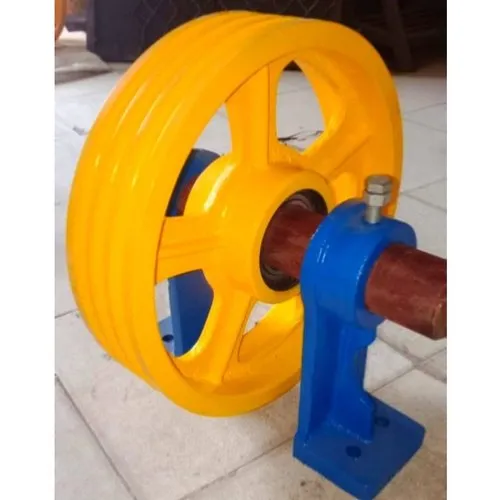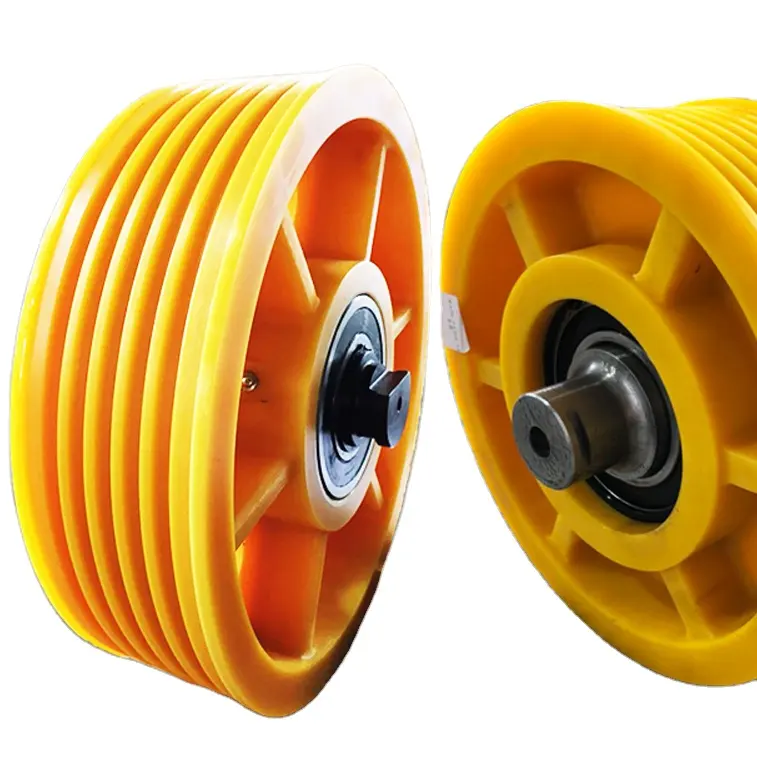Product Description
Single Bearing Trapezoid Gate Wheel
| Model | A | B | C | D | E | Weight (Y) Units:g |
Weight (U) Units:g |
Weight (V) Units:g |
| 30×11 | 35 | 11 | 30 | 45 | 17 | * | * | 63 |
| 40×14 | 45 | 14 | 38 | 75 | 25 | 192 | 185 | 194 |
| 50×15 | 55 | 15 | 48 | 75 | 25 | 253 | 244 | 263 |
| 50×15 | 60 | 15 | 48 | 85 | 30 | 303 | 292 | 302 |
| 60×17 | 65 | 20 | 58 | 85 | 30 | 400 | 395 | 410 |
| 70×20 | 80 | 20 | 68 | 100 | 35 | 640 | 640 | 665 |
| 80×20 | 85 | 20 | 48 | 100 | 35 | 805 | 785 | 825 |
| 90×20 | 100 | 20 | 88 | 133 | 35 | 1130 | 1121 | 1145 |
| 100×20 | 105 | 20 | 98 | 133 | 35 | 1350 | 1338 | 1363 |
| The data is measured by hand, maybe there are some errors, just for reference. | ||||||||
Double Bearing Gate Wheel
| Model | A | B | C | D | E | Weight(Y) | Weight(U) |
| 50MM | 55 | 26 | 48 | 85 | 30 | 324 | 320 |
| 60MM | 65 | 30 | 58 | 85 | 30 | 617 | 580 |
| 70MM | 80 | 32 | 68 | 100 | 35 | 977 | 954 |
| 80MM | 85 | 32 | 48 | 100 | 35 | 1260 | 1223 |
| 90MM | 100 | 32 | 88 | 133 | 35 | 1788 | 1760 |
| 100MM | 105 | 32 | 98 | 133 | 35 | 2100 | 2078 |
| The data is measured by hand, maybe there are some errors, just for reference. | |||||||
Laminated Gate Wheel
| Model | A | B | C | D | Weight(Y/V) | Weight(U) |
| 50mm | 48 | 15 | 100 | 26 | 260 | 250 |
| 60mm | 58 | 17 | 100 | 26 | 390 | 360 |
| 70mm | 68 | 20 | 136 | 33 | 590 | 570 |
| 80mm | 78 | 20 | 136 | 33 | 750 | 725 |
| 90mm | 88 | 20 | 152 | 33 | 1060 | 1030 |
| 100mm | 98 | 20 | 152 | 33 | 1265 | 1225 |
| The data is measured by hand, maybe there are some errors, just for reference. | ||||||
Hang Gate Wheel
| Model | A | B | C | D | E | F | G | H | I |
| H25 | 51 | 25 | M9*50 | 9 | 95 | 79 | 25 | 6 | 27 |
| H38 | 86 | 38 | M12*70 | 11 | 120 | 118 | 38 | 10 | 32 |
| H55 | 115 | 55 | M20*85 | 14 | 140 | 159 | 44 | 10 | 15 |
| The data is measured by hand, maybe there are some errors, just for reference. | |||||||||
Triangle Gate Wheels/ Rotation Gate Wheels/ Hanging Wheels/ White Zinc Gate Wheels/ Doule Wheels Double Bearing Gate Wheel
We have already had nealy a decade producting and exporting experience. Since 2014, we have sold our products to dozens of countries all around the world. And we have established a deep cooperative relationship with many customers.
We make our products with heart, strive to bring the best quality for customers. So we got a lot of customer approval. After that, we will also strictly control, down-to-earth, and forge ahead.
1.ZheJiang Joinwin Hardware and Tools Co., Ltd. we have 10 years manufacturing and exporting experience which ranks among the best in China. Mainly sales pliers, spanners, scissors, saws, screwdrivers, wheels, sillicone sealant, tapline and other hand tools.
2.Located in HangZhou where is just 180km far from HangZhou Port and many raw material factories around, greatly reduces transportation and procurement costs.
3.We have professional sales and engineers to provide satisfied service to clients. Our company covers an area of 1000 square meters, has the most advanced production equipment and technology.
4.Customer first, team work, embrace change, sincere are our company culture.
5.We aim to provide clients more safety and convenient life.
Pliers Adjustable Wrench Combination Spanners Hammers Pruner Scissors Aviation Tin Snips
Screwdrivers Padlocks Hand Saws Axe Silicone Sealant
Q1: Can I get a sample?
A1: Yes, the samples are usually free for customers.
Q2: Can you provide OEM service?
A2: Yes, we can produce the goods according to clients’ demands.
Q3: How can you guarantee the quality?
A3: We have advanced equipment and professional engineer and quality inspector to ensure the quality of the goods. And we will send extra goods for insurance. Besides, we have satisfied after-service.
Q4: What is the MOQ?
A4: 500 PCS.
Q5: How long you will finish my order?
A5: Totally in 30 days. (The specific situation depends on the production schedule of the production department.)
| Certification: | CE |
|---|---|
| Splittable: | Splittable |
| Surface Treatment: | Zinc Plated |
| Material: | Metal |
| Sample: | Free |
| Usage: | Sliding Gate |
| Samples: |
US$ 0.01/Piece
1 Piece(Min.Order) | |
|---|
| Customization: |
Available
| Customized Request |
|---|
How does the quality and precision of lifting pulleys impact the accuracy of lifting operations?
The quality and precision of lifting pulleys have a direct impact on the accuracy of lifting operations. The design, construction, and performance of pulleys influence the control, stability, and reliability of the lifting process. Here’s a detailed explanation of how the quality and precision of lifting pulleys impact lifting operations:
1. Load Control: High-quality lifting pulleys are designed to provide precise and smooth load control. They enable operators to accurately adjust the speed, direction, and position of the load during lifting operations. Pulleys with precise load control capabilities ensure that the load is lifted, lowered, or moved with accuracy and minimal deviation, resulting in precise positioning and placement of the load.
2. Stability and Balance: Precision-engineered lifting pulleys contribute to the stability and balance of the lifting system. They are designed to minimize vibrations, wobbling, or oscillations during the lifting process. This stability ensures that the load remains balanced and steady, reducing the risk of accidents, load shift, or damage to the lifting equipment. The quality of pulleys directly affects the system’s ability to maintain stability and balance throughout the lifting operation.
3. Efficiency and Smooth Operation: High-quality lifting pulleys are engineered to minimize friction and resistance, allowing for efficient and smooth operation. They are often equipped with low-friction mechanisms, such as ball bearings, to reduce energy loss and enable smooth rotation. Pulleys that operate smoothly require less force to lift the load, leading to improved energy efficiency and precise control over the lifting operation.
4. Reduced Jerks and Sudden Movements: Lifting pulleys that exhibit high precision and quality help prevent sudden jerks or uncontrolled movements during lifting. They ensure that the load is lifted or lowered smoothly without abrupt starts or stops. This reduces the risk of shock loads, equipment damage, and potential injury to workers. By minimizing jerks and sudden movements, precise pulleys contribute to the overall safety and accuracy of lifting operations.
5. Load Distribution: Quality lifting pulleys distribute the weight of the load evenly across the lifting system. They enable the load to be spread over multiple ropes or cables, ensuring a well-balanced distribution of forces. This even load distribution minimizes stress on individual components, enhances the system’s stability, and improves the accuracy of load handling and positioning.
6. Minimal Deflection and Stretching: High-quality lifting pulleys are designed to minimize deflection and stretching of the ropes or cables during lifting operations. They ensure that the cables remain aligned and experience minimal elongation or deformation. This reduces the risk of inaccurate load positioning caused by sagging or stretching of the lifting elements, ensuring precise and consistent lifting performance.
7. Reliability and Longevity: The quality of lifting pulleys directly impacts their reliability and longevity. Well-designed pulleys constructed with durable materials and precise manufacturing techniques are more likely to withstand heavy loads, frequent use, and harsh operating conditions. Reliable pulleys contribute to the accuracy of lifting operations by minimizing the chances of unexpected failures or malfunctions that can compromise the precision and safety of the lifting process.
8. Compatibility and
How are lifting pulleys customized for specific lifting requirements and load capacities?
Lifting pulleys can be customized to meet specific lifting requirements and accommodate different load capacities. Manufacturers offer various customization options to ensure that the pulleys are tailored to the specific needs of the lifting application. Here are some common ways in which lifting pulleys are customized:
1. Load Capacity: Lifting pulleys are designed and manufactured to handle different load capacities. Manufacturers specify the maximum load capacity of each pulley, allowing users to select the appropriate pulley based on their specific lifting requirements. Pulleys can be customized to support light loads, heavy loads, or even extreme loads encountered in specialized lifting applications.
2. Sheave Size and Configuration: The sheave, or the wheel of the pulley, can be customized in terms of size and configuration. Larger sheave diameters provide a greater mechanical advantage, allowing for easier lifting of heavy loads. Manufacturers offer pulleys with different sheave sizes and configurations, such as single sheave, double sheave, or multiple sheaves in a block, to accommodate various lifting needs.
3. Material Selection: The choice of material for the pulley can be customized based on factors such as load capacity, environmental conditions, and industry requirements. Different materials, such as steel, cast iron, aluminum, brass, nylon, plastic, or composite materials, offer varying properties in terms of strength, durability, weight, corrosion resistance, and more. Manufacturers select the appropriate material or combination of materials to ensure that the pulley meets the desired specifications.
4. Bearing Type: Lifting pulleys can be customized with different bearing types to optimize performance and efficiency. Common bearing options include plain bearings, ball bearings, or roller bearings. The choice of bearing type depends on factors such as load capacity, speed, noise requirements, and maintenance considerations. Customizing the bearing type allows for smoother rotation of the pulley, reducing friction and improving overall lifting performance.
5. Mounting Options: Lifting pulleys can be customized with various mounting options to suit different installation requirements. Manufacturers offer pulleys with different mounting configurations, such as fixed mount, swivel mount, or combination mounts, allowing users to select the most suitable option for their specific lifting setup.
6. Special Features: Depending on the specific lifting requirements, lifting pulleys can be customized with special features or accessories. For example, pulleys used in high-temperature environments may have heat-resistant coatings or materials. Pulleys used in corrosive environments may have protective coatings or be made from corrosion-resistant materials. Manufacturers can also incorporate features such as locking mechanisms, integrated lubrication systems, or specialized designs to address unique lifting challenges.
By offering customization options in load capacity, sheave size and configuration, material selection, bearing type, mounting options, and special features, manufacturers ensure that lifting pulleys can be adapted to specific lifting requirements and load capacities. This customization allows users to optimize the performance, efficiency, and safety of their lifting operations.
How do lifting pulleys contribute to the smooth and controlled lifting of heavy loads?
Lifting pulleys play a crucial role in achieving smooth and controlled lifting of heavy loads. They provide mechanical advantage and facilitate the efficient transfer of force, allowing operators to lift heavy objects with reduced effort and improved control. Here are several ways in which lifting pulleys contribute to smooth and controlled lifting:
1. Mechanical Advantage: Lifting pulleys employ the principle of mechanical advantage to make lifting heavy loads easier. By using multiple sheaves or wheels, they distribute the load over several ropes or cables. This distribution of load reduces the amount of force required to lift the load. The mechanical advantage provided by lifting pulleys allows operators to exert less force while achieving the desired lifting outcome.
2. Reduction of Friction: Lifting pulleys are designed to minimize friction between the rope or cable and the pulley itself. They often feature smooth, rounded grooves or ball bearings, which reduce the contact area and frictional forces. By reducing friction, lifting pulleys enable smoother movement of the lifting medium, such as a rope or cable, resulting in a more controlled lifting process.
3. Change of Direction: Lifting pulleys allow for changes in the direction of the lifting force. By redirecting the force at different angles, pulleys enable lifting from various positions, even in confined spaces. This capability enhances flexibility and control during lifting operations, allowing operators to maneuver heavy loads with precision.
4. Force Amplification: Lifting pulleys amplify the input force applied by the operator. As the force is transmitted through the pulley system, the load experiences increased lifting force. This force amplification can be particularly beneficial when dealing with heavy loads that would require excessive force to lift without the mechanical advantage provided by the pulleys.
5. Controlled Speed: Lifting pulleys offer control over the lifting speed. By adjusting the tension and angle of the ropes or cables, operators can regulate the rate at which the load is lifted or lowered. This control is crucial for delicate or sensitive loads that require careful handling and precise positioning.
6. Stability and Safety: Lifting pulleys contribute to the stability and safety of lifting operations. They help to evenly distribute the load, reducing the risk of imbalance or tipping. Additionally, the mechanical advantage provided by the pulleys allows for smoother and more controlled movements, minimizing the likelihood of sudden jolts or jerks that could compromise the safety of the load, equipment, or personnel involved.
By utilizing mechanical advantage, reducing friction, enabling changes in direction, amplifying force, providing controlled speed, and enhancing stability and safety, lifting pulleys significantly contribute to the smooth and controlled lifting of heavy loads. Their design and functionality make them indispensable tools in various industries where material handling and lifting operations are essential.
editor by CX
2023-10-07




